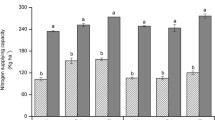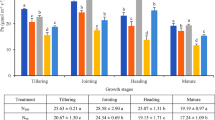Abstract
Currently, it is difficult to synergistically improve rice yield and nitrogen (N) use efficiency (NUE) resulted from the overuse of N fertilizer under different rotations has become a major issue in China. This study was undertaken to optimize N application and evaluate the feasibility of reducing the amount of N fertilizer in rice crops under different rotations. Three rotations (mustard-rice, rape-rice, and wheat-rice) and different N application strategies (conventional N management and optimum N application strategies according to the Stanford equation) were tested in 2019 and 2020. The relationship between yield or NUE and N accumulation and translocation was, respectively, investigated. Correlation analyses revealed that the yield or NUE was significantly correlated (r = 0.446–0.977, P < 0.05) with the N translocation in stem-sheaths, N translocation contribution rate in blades, and N accumulation from full heading to maturity stage. These results suggest that the N application strategy should be adjusted according to different rotations in order to obtain the highest yield and the best NUE. When the N fertilizer was 105, 125, and 150 kg ha−1, and the N fertilizer ratio all were 30:30:40 base to tiller to panicle fertilizer, rape-rice, mustard-rice, and wheat-rice rotations each achieve a synergistic increased N accumulation and translocation from full heading to maturity stage and hence, attained higher yield and NUE. The results further indicated that it is practicable to reduce the amount of N fertilizer applied in rice crops planted after rape or mustard but not when grown after wheat.




Similar content being viewed by others
References
Arnall B (2016) Methods of making variable-rate nitrogen recommendations. Crops & Soils 49:24–27
Autret B, Mary B, Strullu L, Chlebowski F, Mäder P, Mayer J, Olesen JE, Beaudoin N (2020) Long-term modeling of crop yield, nitrogen losses and GHG balance in organic cropping systems. Sci Total Environ 710:134597
Bais HP, Weir TL, Perry LG, Gilroy S, Vivanco JM (2006) The role of root exudates in rhizosphere interactions with plants and other organisms. Annu Rev Plant Biol 57:233–266
Bennett AJ, Bending GD, Chandler D, Hilton S, Mills P (2012) Meeting the demand for crop production: The challenge of yield decline in crops grown in short rotations. Biol Rev 87:52–71
Chen S, Liu SW, Zheng X, Yin M, Chu G, Xu CM, Yan JX, Chen LP, Wang DY, Zhang XF (2018) Effect of various crop rotations on rice yield and nitrogen use efficiency in paddy-upland systems in southeastern China. Crop J 6:576–588
Deng F, Li W, Wang L, Hu H, Liao S, Pu SL, Tao YF, Li GH, Ren WJ (2020) Effect of controlled-release fertilizers on leaf characteristics, grain yield, and nitrogen use efficiency of machine-transplanted rice in southwest China. Arch Agron Soil Sci 67:1739–1753
Fang YT, Ren T, Zhang ST, Liu Y, Liao SP, Li XK, Cong RH, Lu JW (2021) Rotation with oilseed rape as the winter crop enhances rice yield and improves soil indigenous nutrient supply. Soil till Res 212:105065
Ferguson RB, Hergert GW, Schepers JS, Gotway CA, Cahoon JE, Peterson TA (2002) Site-specific nitrogen management of irrigated maize. Soil Sci Soc Am J 66:544–553
Huang S, Zeng YJ, Wu JF, Shi QH, Pan XH (2013) Effect of crop residue retention on rice yield in China: a meta-analysis. Field Crop Res 154:188–194
Huang LY, Yang DS, Li XX, Peng SB, Wang F (2019) Coordination of high grain yield and high nitrogen use efficiency through large sink size and high post-heading source capacity in rice. Field Crops Res 233:49–58
Ju XT, Xing GX, Chen XP, Zhang SL, Zhang LJ, Liu XJ, Cui ZL, Yin B, Christie P, Zhu ZL, Zhang FS (2009) Reducing environmental risk by improving N management in intensive Chinese agricultural systems. Proc Natl Acad Sci USA 106:3041–3046
Ku H, Hayashi K, Agbisita R, Villegas-Pangga G (2017) Effect of rates and sources of nitrogen on rice yield, nitrogen efficiency, and methane emission from irrigated rice cultivation. Arch Agron Soil Sci 63:1009–1022
Liao P, Huang S, Van Gestel NC, Zeng YJ, Wu ZM, van Groenigen KJ (2018) Liming and straw retention interact to increase nitrogen uptake and grain yield in a double rice-cropping system. Field Crops Res 216:217–224
Liu SL, Huang DY, Chen AL, Wei WX, Brookes PC, Li Y, Wu JS (2014) Differential responses of crop yields and soil organic carbon stock to fertilization and rice straw incorporation in three cropping systems in the subtropics. Agric Ecosyst Environ 184:51–58
Liu BB, Wu QR, Wang F, Zhang B (2019) Is straw return-to-field always beneficial? Evidence from an integrated cost-benefit analysis. Energy 171:393–402
Lu S, Lepo JE, Song HX, Guan CY, Zhang ZH (2018) Increased rice yield in long-term crop rotation regimes through improved soil structure, rhizosphere microbial communities, and nutrient bioavailability in paddy soil. Biol Fert Soils 54:909–923
Ma P, Lan Y, Lyu TF, Zhang YJ, Lin D, Li FJ, Li Y, Yang ZY, Sun YJ, Ma J (2020) Improving rice yields and nitrogen use efficiency by optimizing nitrogen management and applications to rapeseed in rapeseed-rice rotation system. Agronomy 10:1060
Mohammed YA, Kelly J, Chim BK, Rutto E, Waldschmidt K, Mullock J, Torres G, Desta KG, Raun W (2013) Nitrogen fertilizer management for improved grain quality and yield in winter wheat in Oklahoma. J Plant Nutr 36:749–761
Nawaz A, Farooq M, Nadeem F, Siddique KHM, Lal R (2019) Rice-wheat cropping systems in South Asia: issues, options and opportunities. Crop Pasture Sci 70:395–427
Pampolino MF, Manguiat IJ, Ramanathan S, Gines HC, Tan PS, Chi TTN, Rajendran R, Buresh RJ (2007) Environmental impact and economic benefits of site-specific nutrient management (SSNM) in irrigated rice systems. Agric Syst 93:1–24
Polthanee A, Tre-loges V, Promsena K (2008) Effect of rice straw management and organic fertilizer application on growth and yield of dry direct-seeded rice. Paddy Water Environ 6:237–241
Shan AQ, Pan JQ, Kang KJ, Pan MH, Wang G, Wang M, He ZL, Yang XE (2021) Effects of straw return with N fertilizer reduction on crop yield, plant diseases and pests and potential heavy metal risk in a Chinese rice paddy: a field study of 2 consecutive wheat-rice cycles. Environ Pollut 288:117741
Stanford G (1973) Rationale for optimum nitrogen fertilization in corn production. J Environ Qua 2:159–166
Sun Y, Ma J, Sun Y, Xu H, Yang Z, Liu S, Jia X, Zheng H (2012) The effects of different water and nitrogen managements on yield and nitrogen use efficiency in hybrid rice of China. Field Crops Res 127:85–98
Sun YJ, Yan FJ, Sun YY, Xu H, Guo X, Yang ZY, Yin YZ, Guo CC, Ma J (2018) Effects of different water regimes and nitrogen application strategies on grain filling characteristics and grain yield in hybrid rice. Arch Agron Soil Sci 64:1152–1171
Sun YJ, Sun YY, Yan FJ, Li Y, Wu YX, Guo CC, Ma P, Yang GT, Yang ZY, Ma J (2020) Coordinating postanthesis carbon and nitrogen metabolism of hybrid rice through different irrigation and nitrogen regimes. Agronomy 10:1187
Tian K, Zhao YC, Xu XH, Hai N, Huang BA, Deng WJ (2015) Effects of long-term fertilization and residue management on soil organic carbon changes in paddy soils of China: a meta-analysis. Agric Ecosyst Environ 204:40–50
Wang J, Wang D, Zhang G, Wang Y, Wang C, Teng Y, Christie P (2014) Nitrogen and phosphorus leaching losses from intensively managed paddy fields with straw retention. Agric Water Manag 141:66–73
Wei HH, Meng TY, Li C, Zhang HC, Dai QG, Ma RR, Wang XY, Yang YW (2016) Accumulation, translocation and utilization characteristics of nitrogen in Yongyou 12 yielding over 13·5 t ha-1. Acta Agron Sin 42(9):1363–1373
Yan FJ, Sun YJ, Xu H, Yin YZ, Wang HY, Wang CY, Guo CC, Yang ZY, Sun YY, Ma J (2018) Effects of wheat straw mulch application and nitrogen management on rice root growth, dry matter accumulation and rice quality in soils of different fertility. Paddy Water Environ 16:507–518
Yan FJ, Sun YJ, Xu H, Jiang MJ, Xiang KH, Wu YX, Zhang Q, Tang Y, Yang ZY, Sun YY, Ma J (2019) The effect of straw mulch on nitrogen, phosphorus and potassium uptake and use in hybrid rice. Paddy Water Environ 17:23–33
Yin HJ, Zhao WQ, Li T, Cheng XY, Liu Q (2018) Balancing straw returning and chemical fertilizers in China: role of straw nutrient resources. Renew Sust Energ Rev 81:2695–2702
Yoshida S, Forno DA, Cock DH, James KA (1976) Laboratory manual for physiological studies of rice. Int Rice Res Inst. 83
Zadoks JC, Chang TT, Konzak CF (1974) A decimal code for the growth stages of cereals. Weed Res 14:415–421
Zhang L, Zheng JC, Chen LG, Shen MX, Zhang X, Zhang MQ, Bian XM, Zhang J, Zhang WJ (2015) Integrative effects of soil tillage and straw management on crop yields and greenhouse gas emissions in a rice-wheat cropping system. Eur J Agron 63:47–54
Zhang L, Zhou LH, Wei JB, Xu HQ, Tang QY, Tang JW (2020) Integrating cover crops with chicken grazing to improve soil nitrogen in rice fields and increase economic output. Sci Total Environ 713:135–218
Zhang SJ, Zhang G, Wang DJ, Liu Q, Xu M (2021) Investigation into runoff nitrogen loss variations due to different crop residue retention modes and nitrogen fertilizer rates in rice-wheat cropping systems. Agri Water Manag 247:106729
Zhu Y, Liao SP, Liu Y, Li XK, Ren T, Cong RH, Lu JW (2019) Differences of annual nutrient budgets between rapeseed-rice and wheat-rice rotations in the Yangtze River Basin. J Plant Nutr Fert 25:64–73
Funding
This work was supported by Key Science and Technology Special Projects in Sichuan Province of the cultivation of green and efficiency super rice varieties (2022ZDZX0012), the National Industrial Technology System Rice Cultivation in the Upper Yangtze River (CARS-01–25); the Project Foundation of the State Key Laboratory of Crop Gene Exploration and Utilization in Southwest China (SKL-ZY202228); the Rice Breeding Project Foundation of Sichuan Provincial Science and Technology Department (2021YFYZ0005).
Author information
Authors and Affiliations
Corresponding author
Ethics declarations
Conflict of interest
No potential conflict of interest was reported by the authors.
Rights and permissions
Springer Nature or its licensor (e.g. a society or other partner) holds exclusive rights to this article under a publishing agreement with the author(s) or other rightsholder(s); author self-archiving of the accepted manuscript version of this article is solely governed by the terms of such publishing agreement and applicable law.
About this article
Cite this article
Sun, Y., Lin, D., Sun, Y. et al. Improving yield and nitrogen use efficiency of hybrid indica rice through optimizing nitrogen application strategies in the rice season under different rotation patterns. Paddy Water Environ 21, 99–113 (2023). https://doi.org/10.1007/s10333-022-00916-4
Received:
Revised:
Accepted:
Published:
Issue Date:
DOI: https://doi.org/10.1007/s10333-022-00916-4




